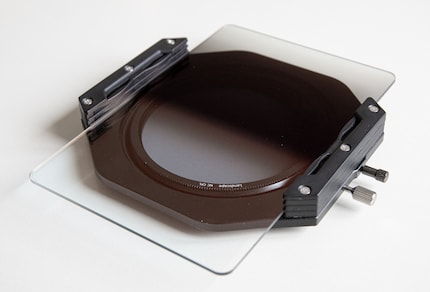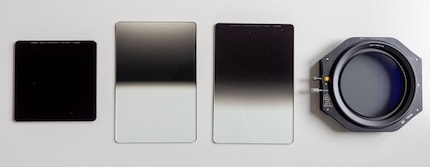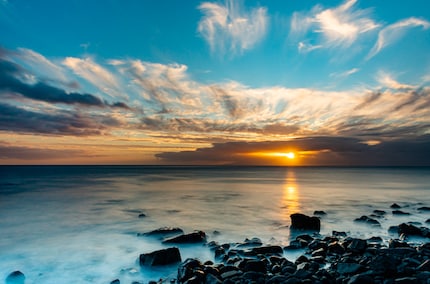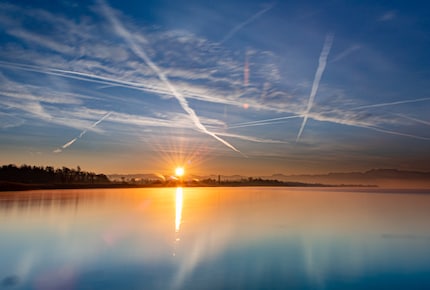
Guide
Photo editing: equalising differences in brightness
by David Lee

Filter holders are expensive and cumbersome. But they are necessary for graduated filters - and these can be extremely useful in landscape photography. I therefore tried out a filter system from Nisi.
A common problem in landscape photography: the sky is too bright compared to the rest. This means that either the sky is overexposed and loses detail, or everything below is far too dark - you can't get both right at the same time.
This can be corrected to a certain extent in image editing, especially if you are shooting in RAW format. But there are limits. Even with the best sensors available today.
This is why there are grey gradient filters: they work according to the motto "it's better to take the right picture than to correct it afterwards". They darken the upper area of the image and let the light through in the lower area. The transition between light and dark is smooth.
For this to work, such a filter must be height-adjustable. Because you don't always want the horizon in exactly the same place. And that in turn is the reason why grey graduated filters cannot simply be screwed in front of the lens in the form of a disc like all other filters. You need a holder that makes the filter adjustable in height.

Nisi is a manufacturer of such filter systems. It offers various sets that differ in terms of the number of filters and other accessories. However, most of them are also available individually. The filter holder is available in a version 5 and a version 6, with some minor handling improvements in the latest version. I am testing the Nisi V6 Starter Kit Plus here.

Nisi V6 Starter Kit Plus 100mm
Neutral density filter, Graduated neutral density filter, 100 mm
This contains a whole host of different filters.
This may seem cumbersome, but there is no other way. A normal polarising filter screwed in front of the lens would also rotate the entire mount, as it is attached to the filter thread. The polarising filter must therefore also be integrated into the mount.

This starter kit is quite expensive - but you also get a lot. In addition to the filters, the scope of delivery includes:
Adapters for different lens sizes: 67, 72, 77 millimetres. The thread without additional adapter measures 82 millimetres. If you want to take photos with a smaller lens, Nisi offers adapter rings for practically every size. The rings of the Nisi V5 and V6 systems are compatible with each other.
Also included is the Clever Cleaner, a tool for quickly cleaning the filters, a cleaning cloth and a bellows. The quick cleaning tool helped me a lot. However, I don't know how long it will remain effective. Nevertheless, it can be purchased at a favourable price. It is important that the filters are as clean as possible, because dust particles reflect and create small bright colour dots on the image.
The scope of delivery also includes a protective cap and a bag that can be attached to the tripod with an integrated loop. Although the bag is of solid quality, I find it too tight. I would like to leave the adapter, holder, polarising filter and rubber cap screwed together and stow them away, but that is only possible with a lot of effort.

Nisi V6 Starter Kit Plus 100mm
Neutral density filter, Graduated neutral density filter, 100 mm
The sunsets on the Canary Island of La Gomera seemed ideal for me to try out the filter set. I actually managed to take some beautiful photos with it, but also learnt the pitfalls of the system.

I realised right at the start that my small travel tripod wasn't stable enough to hold the SLR camera and filter system. I had to manage without a tripod somehow. Nevertheless, I didn't want to do without long exposures, because the flowing water is a nice part of the fascination of such pictures. Placing the camera on a base was not easy either, as the filters protrude from the bottom. I finally managed it by placing the camera right at the front on a wall.
You also only have a short time for sunsets. The closer to the equator, the more extreme it gets. However, the filter system is not for snapshots, but requires careful set-up. Especially at the beginning, when you lack experience with it, you will quickly find yourself under time pressure. So be sure to clean the filters beforehand, assemble the adapter and attach it to the camera. In addition, the exposure should be roughly correct on the first attempt, which is not always easy with long exposures. Nisi offers a very simple but useful app for this (Android and iOS). You enter the exposure time without filter and the filter strength, and the app calculates the required exposure time with filter.
Back at home, I wanted to delve a little deeper into the matter. For example, I couldn't expose for longer than 30 seconds when I was on holiday because I didn't have a remote shutter release with me. The longer the exposure, the smoother the water becomes and the better the reflections in the water are visible. This photo is exposed for 70 seconds.

This worked well, but here another problem becomes apparent. Due to the reflection of the sun in the water, the lower part of the image is also bright. Neither the normal nor the reversed grey gradient filter really fit. In extreme cases, the graduated filters are of no use at all. This was not the case here. The sky is darker than the water with the graduated filter, but this can be corrected with image processing. The overall difference in brightness is still smaller than without the filter - and therefore the quality is better.

Fun fact: I had to take this photo session without a tripod again - the tripod plate fell into the lake as soon as I unpacked the tripod.
If the horizon is at an angle due to a mountain slope, the filter system can be rotated and aligned accordingly. Nevertheless, there are certainly many situations where the brightness in the image is not so evenly distributed that it can be evened out nicely with a graduated filter. This would be the case, for example, in a valley with two opposing mountain slopes, with a large object in the foreground (tree or house), or with highly reflective water.
Although cameras today offer more dynamic range than in the past, graduated filters still make a significant difference. They enable images that would otherwise not be possible. I have nothing to criticise about Nisi's specific solution. The system is solid and well thought out. Competing products are unlikely to be any better.
But the fundamental question is whether it's worth the effort for you. The handling of such a system is not for the impatient - in any case, it is much more complicated than with filters that are screwed directly onto the lens. On the other hand, such a set doesn't cost very little either. However, the price is somewhat relativised by the fact that the system can be used for any camera and is hardly ever outdated.
My interest in IT and writing landed me in tech journalism early on (2000). I want to know how we can use technology without being used. Outside of the office, I’m a keen musician who makes up for lacking talent with excessive enthusiasm.